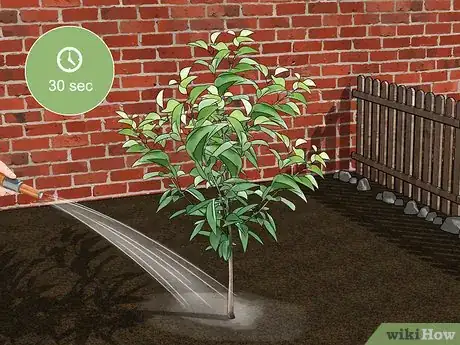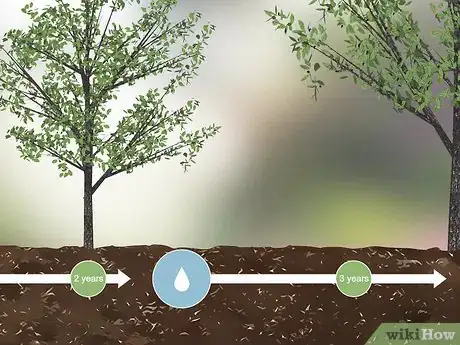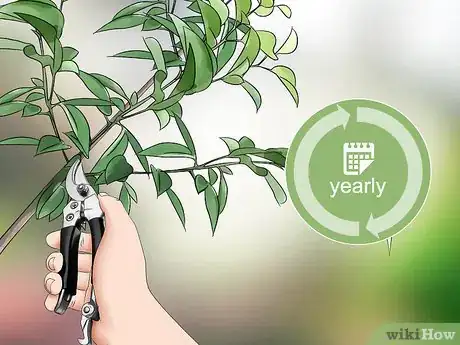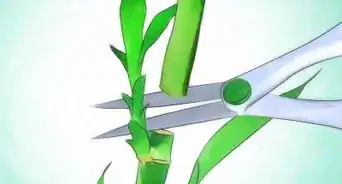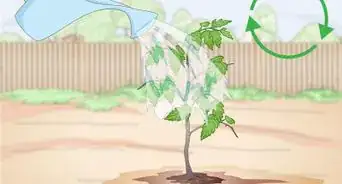This article was co-authored by Mike Garcia and by wikiHow staff writer, Kyle Hall. Mike Garcia is a Licensed Landscape Contractor and the Founder of Enviroscape LA, a full-service landscape design and construction firm in Los Angeles, California. With over 30 years of experience, Mike specializes in sustainable landscape practices. Mike holds an Ornamental Horticulture degree, C-27 Landscape Contractor and D-49 Tree Service Contractor licenses, and Permaculture Design, California Naturalist, International Certified Professional Pond Contractor, and Pond Building certifications. He is one of eight Internationally Certified Pond Builders in the world. Enviroscape LA has won landscape and water feature awards from the International Professional Pond Contractors Association (IPPCA), National Association of Pond Professionals (NAPP), and the California Landscape Contractors Association (CLCA). Mike is a past president of the CLCA and currently serves on their local Board of Directors. Enviroscape LA has been featured in PONDS USA Magazine, Pond and Garden Lifestyles Magazine, and the Los Angeles Times. Mike has appeared on Extreme Home Makeover, HGTV's Landscapers Challenge, and A & E's series Fix That Yard.
This article has been viewed 71,244 times.
Caring for a tree and watching it grow can be a rewarding experience. It's important to take care of your tree during its first few years so it establishes strong roots and grows to be green and healthy.
Steps
Watering
-
1Water your tree thoroughly right after you plant it. Watering your tree right away will help settle the soil and mulch, and it will give the roots moisture they need to start growing. Don't soak the soil around your tree. Spraying it with a gardening hose for 30 seconds should give it enough water.[1]
-
2Keep the soil moist if your tree is less than 2 years old. Whenever the soil looks dry, water your tree with a garden hose for about 30 seconds. Young trees need lots of water so they can establish their roots in the soil. Don’t over water your tree though, or you could cause root rot. The soil should be moist, not soaking wet. [2]
- To check if the soil is moist enough, insert a garden trowel 2 inches (5.1 cm) into the soil and pull it out. Stick your finger down in the hole and to see if the soil feels moist. If it doesn’t, your tree needs to be watered.[3]
Advertisement -
3Cut back on watering your tree after it's older than 2 years. After 2 years, the roots on your tree should be established and it won't need as much water to grow. If you live in an area that gets regular rainfall, you won't need to worry about watering your tree , unless it's a species that needs a lot of water. If you live in a dry climate, you may need to water your tree regularly to keep it healthy.[4]
- Look up your species of tree online to find out specific watering recommendations.
Mulching
-
1Mulch your tree as soon as possible after you plant it. Mulching a newly-planted tree is important because it insulates the roots from extreme temperatures and helps keep them moist. Mulch can also serve as a visual for where you shouldn't mow when you mow your lawn.[5]
-
2Clear any grass within a 3–10 foot (0.91–3.05 m) area around your tree. The exact size of the area you should clear depends on how big your tree is. For a smaller tree, clear a smaller area, and for a bigger tree, clear a bigger area. Use a rake or tiller to clear away the grass.[6]
-
3Spread a 3 inch (7.6 cm) layer of natural mulch around your tree. Wood chips or pieces of bark will work. Make sure the layer of mulch is at least 3 feet (0.91 m) in diameter.[7]
-
4Leave a 3 inch (7.6 cm) ring between the trunk and the mulch. This prevents the mulch from smothering your tree. The flare of the trunk shouldn't be covered with mulch.[8]
Pruning
-
1Remove dead branches from your tree throughout the year. Routinely pruning off dead branches will keep your tree looking healthy. Dead branches will be leafless, and the bark may be falling off them.[9]
-
2Avoid excessive pruning if your tree is less than 3 years old. You want your tree to have as much leaf space as possible for its first few years so it can get more nutrients and develop strong roots. Only prune off dead or broken branches during the first 3 years of your tree’s life.
-
3Start pruning your tree annually after its older than 3 years. Try to prune your tree during the winter to encourage growth. Once a year, prune excessive or undesirable branches from your tree so there’s less competition for water and nutrients. When your tree starts to develop a shape, cut back branches that extend out of the lines of the shape you want.
-
4Avoid leaving stubs when you make cuts on your tree. Stubs can cause your tree to develop disease or pest problems. When you prune your tree, make your cut lines right where the branch collar ends and the branch begins. The branch collar is the raised, volcano-shaped section of the branch that’s connected to the rest of the tree.[10]
- Avoid making cuts that are flush with your tree. Always cut outside of the branch collar.
-
5Prune any sprouts growing out of the base of your tree. Sprouts, also called suckers, are thin shoots that steal water and nutrients from the rest of the tree they’re growing off. Use sharp pruning shears to clip the sprouts off as close to the soil or trunk of your tree as you can. If there are sprouts that are too thick to cut with shears, use loppers to clip them off instead.[11]
-
6Prune branches that are growing in toward the trunk of your tree. This will prevent branches from crossing each other and ruining the shape of your tree. Use pruning shears, loppers, or a hand saw to cut the branches off right outside the branch collar.[12]
Expert Q&A
Did you know you can get expert answers for this article?
Unlock expert answers by supporting wikiHow
-
QuestionHow does a tree grow step by step?
 Maggie MoranMaggie Moran is a Professional Gardener in Pennsylvania.
Maggie MoranMaggie Moran is a Professional Gardener in Pennsylvania.
Home & Garden Specialist
-
QuestionHow can we help trees?
 Maggie MoranMaggie Moran is a Professional Gardener in Pennsylvania.
Maggie MoranMaggie Moran is a Professional Gardener in Pennsylvania.
Home & Garden Specialist
-
QuestionHow often should you water your tree?
 Maggie MoranMaggie Moran is a Professional Gardener in Pennsylvania.
Maggie MoranMaggie Moran is a Professional Gardener in Pennsylvania.
Home & Garden Specialist
References
- ↑ http://www.mortonarb.org/trees-plants/tree-and-plant-advice/horticulture-care/watering-trees-and-shrubs
- ↑ http://www.mortonarb.org/trees-plants/tree-and-plant-advice/horticulture-care/watering-trees-and-shrubs
- ↑ http://www.mortonarb.org/trees-plants/tree-and-plant-advice/horticulture-care/watering-trees-and-shrubs
- ↑ http://www.mortonarb.org/trees-plants/tree-and-plant-advice/horticulture-care/watering-trees-and-shrubs
- ↑ https://caseytrees.org/resources-list/how-to-care-for-trees/
- ↑ https://caseytrees.org/resources-list/how-to-care-for-trees/
- ↑ https://caseytrees.org/resources-list/how-to-care-for-trees/
- ↑ https://caseytrees.org/resources-list/how-to-care-for-trees/
- ↑ https://www.na.fs.fed.us/spfo/pubs/howtos/ht_prune/htprune-rev-2012-print.pdf
- ↑ https://caseytrees.org/resources-list/how-to-care-for-trees/
- ↑ https://caseytrees.org/resources-list/how-to-care-for-trees/
- ↑ https://caseytrees.org/resources-list/how-to-care-for-trees/
- ↑ Mike Garcia. Licensed Landscape Contractor. Expert Interview. 20 November 2020.
- ↑ Mike Garcia. Licensed Landscape Contractor. Expert Interview. 20 November 2020.
About This Article
If you're taking care of a tree that's 2-3 years old, water it with a gardening hose for 30 seconds whenever the soil looks dry. Add a 3 inch (7.6 cm) layer of natural mulch around your tree to help it retain moisture. Avoid pruning your tree until it's older, except to clip off dead branches. If you're taking care of an older tree, prune it annually by cutting off any sprouts and unwanted branches. Water it regularly if you live in a dry climate, or cut back on watering if you get regular rainfall. To learn how to prune your tree without damaging it, read on!
